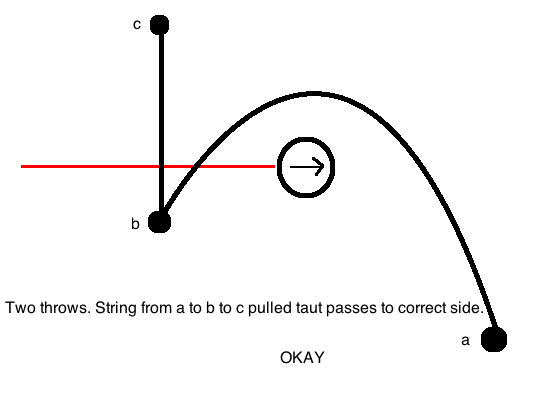Cgkdisc
.:Hall of Fame Member:.
That's true and is a reason to avoid design elements on holes with potentially fuzzy, difficult to define or unnecessary lines.Which is an indictment of all lines.
Discover new ways to elevate your game with the updated DGCourseReview app!
It's entirely free and enhanced with features shaped by user feedback to ensure your best experience on the course. (App Store or Google Play)
That's true and is a reason to avoid design elements on holes with potentially fuzzy, difficult to define or unnecessary lines.Which is an indictment of all lines.
It's not the "simplicity" of a line in the rules but it's how to define, mark, inform players, see and retain the markings well enough to make proper calls in the field.
Has this violation ever actually been called by either the group (highly unlikely imo) or an official (somewhat more likely)?
Abandon all hope all ye who enter.
Easiest way to think about it:
Mandos = here's a line you cannot cross at any point on this hole. If I cross it at any point, it's a penalty.
OB = here's a line you cannot come to rest beyond at any point on this hold. If I come to rest past that at any point, its a penalty.
I'm not saying you, but people have way overcomplicated this over the last year and it's as simple as I posted.
You need to be nice to those people.
YAY!!! The RULE ITSELF is that simple. Glad you pointed that out.
You need to be nice to those people.
YAY!!! The RULE ITSELF is that simple. Glad you pointed that out.
Except that's not the rule.
It's a plane you cannot break. Sure a line is a 1D representation of the plane projected on to the ground.
It's not a matter of "crossing" the line, it's a matter of touching it.
99.9999% of your disc can "cross" and OB line and be in-bounds. 0.000000000% of a disc can "cross" a projected mando line.
And me having to explain this is why it is a poorly written rule.
Mandos = here's a line you cannot cross at any point on this hole. If I cross it at any point, it's a penalty.
OB = here's a line you cannot come to rest beyond at any point on this hold. If I come to rest past that at any point, its a penalty.
It's honestly that simple. Waaaaaaaaaaaaaaaay overthinking and comparing two completely unrelated rules.
Your mando rule is still wrong. Please read it
Schematics with the word cross, plane, etc.
Semantics, is the word I believe you were looking for...
But words have meaning, and "cross" is not the same as "touch"
Semantics, is the word I believe you were looking for...
But words have meaning, and "cross" is not the same as "touch"
Your mando rule is still wrong. Please read it
You need to be nice to those people.
YAY!!! The RULE ITSELF is that simple. Glad you pointed that out.
are you really arguing about "cross" vs "touch" on a plane that you can't physically see from a distance :|
also, cuz i had to look here's the rule
Mando tree is 80 feet away. I gotta go to the right of it. I hang a 30 foot high curtain on the edge of the tree and stretch it to the left corner (as you face fairway) of the tee area (concrete pad). Hitting the curtain would be crossing the plane.
Since it is possible to release the disc " behind the curtain " standing on the left edge of the pad, am I supposed to keep to the right of the pad?
Exactly where does the fairway begin? Is it wide at the end of the pad (or back of )or does it begin on the two edges on the front (or back) of the pad and -V- out?
Mando tree is 80 feet away. I gotta go to the right of it. I hang a 30 foot high curtain on the edge of the tree and stretch it to the left corner (as you face fairway) of the tee area (concrete pad). Hitting the curtain would be crossing the plane.
Since it is possible to release the disc " behind the curtain " standing on the left edge of the pad, am I supposed to keep to the right of the pad?
Exactly where does the fairway begin? Is it wide at the end of the pad (or back of )or does it begin on the two edges on the front (or back) of the pad and -V- out?

the new rule says the td can mark the mando line any way they want, so in the image above it is a missed mando. below i've drawn a couple of example mando lines where the flight doesn't miss mando. the pink line is what your describing. i wouldn't see a td doing this, but yes, if that is the line the td specifies, then throwing from the left side of the tee has a good chance of going through the plane and missing mandoI think this picture addresses the situation you're describing:

The old rule -the line was drawn from the Mando tree perpendicular to the tee. The new rule (if I understand it)
Would be a plane from the Mando object to the tee.
-a- is the tee and -c- is the target
I think this picture addresses the situation you're describing:

The old rule -the line was drawn from the Mando tree perpendicular to the tee. The new rule (if I understand it)
Would be a plane from the Mando object to the tee.
-a- is the tee and -c- is the target
....
The new rule (if I understand it)
Would be a plane from the Mando object to the tee.
-a- is the tee and -c- is the target